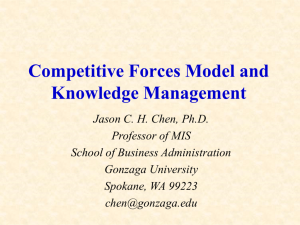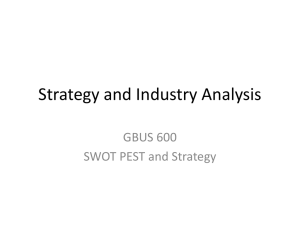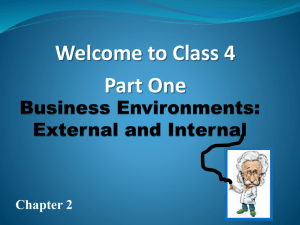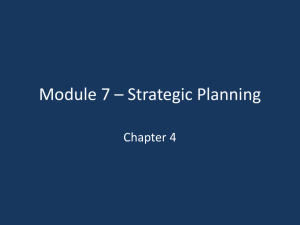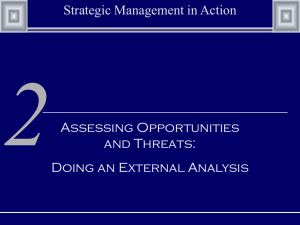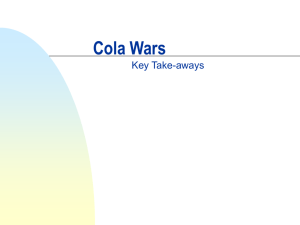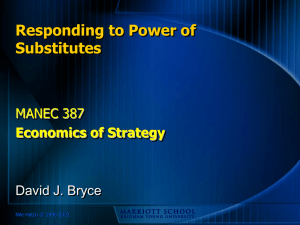The Next Economy
advertisement
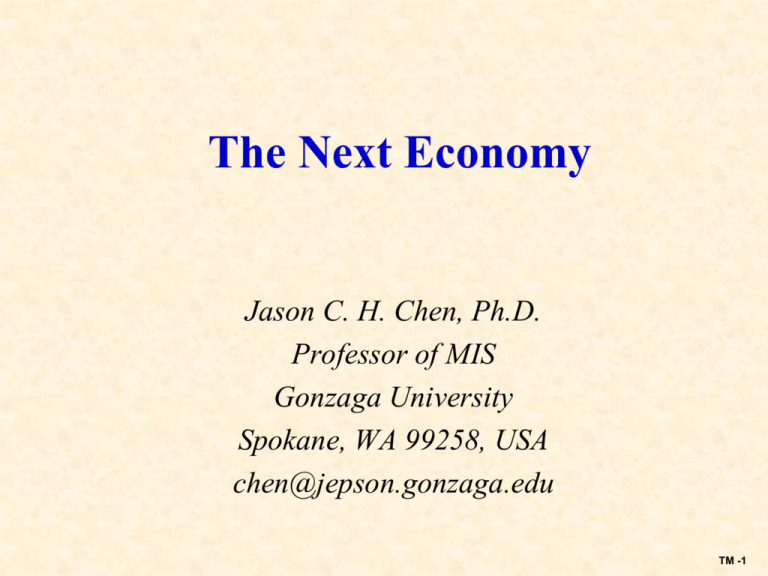
The Next Economy Jason C. H. Chen, Ph.D. Professor of MIS Gonzaga University Spokane, WA 99258, USA chen@jepson.gonzaga.edu TM -1 The Economies OLD Economy (4P) • • • • Price Place Product Promotion Information MIS/IS/IT: Internet/ Data mining/ CRM … Next Economy (4R) • • • • Relationship Retrenchment Relevancy Reward TM -2 The Economies OLD Economy (4P’s) New Economy (4C’s) • • • • • • • • Price Place Product Promotion Information Customer Cost Convenience Communication Next Economy (4R’s) • • • • Relationship Retrenchment Relevancy Reward Knowledge MIS/IS/IT/ICT: Internet/ Data mining/ CRM … TM -3 Questions from Customers … Your customer asks: We are promoting our products, tell me … Solution … NEW Economy (1994-2000) How can INTERNET save (help) us? Post Economy (2001-2008) Where are our customers? How can we contact them? TM -4 The Evolutions of Economy Based on OLD Economy NEW Economy Post Economy (1994-2000) (2001-2008) Product/Service Information/ Internet Knowledge Time to market/ Site visitation Wallet share/ Profit Measurement Market share of success Focus Economies of Scale/ Technology Efficiency Improvement Retaining customers/ Win service N TM -5 Four Important Entities for a Successful Enterprise • Capital • Technical • Human (资本) (技术) (人才) • Information (信息) TM -6 Organizational Ware Strategy HW Structure Organizational Ware SW Culture N TM -7 Essentials for a Successful Enterprise competition structure/ culture Value proposition 1. Business model Business landscape Internal/ External fulfill 2. Core competencies Strategic intent Analysis (Porter, SWOT) 3. Execution (processes?) Technology H/R Management Process Finance … future positioning Strategy Corporate strategy •Positioning on product/market Business strategy •Differentiation/choice of competitive advantage Functional strategy IT Role? Positioning •Competitive posture Industry characteristics, Market growth, Demand characteristics, Barrier of entry,etc. N TM -8 Major Issues for the Next Society 1. Internationalization 4I + 1K 2. Technology Internationalization Integration Innovation Information and Knowledge 3. Population TM -9 Three Themes … Three themes are of interest/important to the business professionals: 1. Enterprise systems Software packages designed to provide complete integration of an organization’s business processing systems and all related data. 2. E-Business The application of electronic networks (including the Internet) to undertake business processes between organizations and either individuals or other organizations. 3. Information Technology It encompasses any hardware, software, or communication technology that might be adopted by an organization to support or control a business process, enable management decisions, or provide a competitive advantage. N TM -10 PORTER’S FIVE COMPETITIVE FORCES MODEL Threats NEW MARKET ENTRANTS Internal Forces 1.customer focus 2.communication 3.core competencies 4.complexity 5.quality SUPPLIERS THE FIRM SUBSTITUTE PRODUCTS & SERVICES TRADITIONAL COMPETITORS Bargaining power CUSTOMERS N Dr. Chen, The Trends of the Information Systems Technology TM -11 Competitive Force Model Entry barriers Economies of scale Proprietary product differences Brand identity Switching cost Capital requirements Access to distribution Government policy Expected retaliation Suppliers New entrants Threat of new entrants Industry competitors Bargaining power of buyers Bargaining power of suppliers Determinants of supplier power Importance of volume to supplier Presence of substitute inputs Switching cost ... Determinants of substitution threat Relative price/performance of substitutes Switching cost… Intensity of rivalry Rivalry Determinants Industry growth Brand identity Switching cost…. Buyers Determinants of buyer power Bargaining Leverage Price Sensitivity Buyer volume Brand identity Switching cost Product differences Buyer information Buyer profits …. Threat of substitutes Substitutes (Source: Porter, 1980) N TM -12
